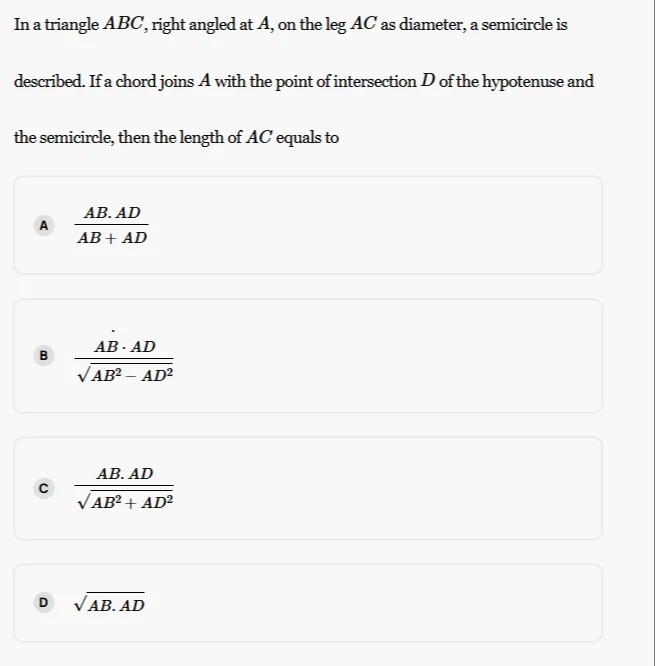Question
Question: In a triangle $ABC$, right angled at $A$, on the leg $AC$ as diameter, a semicircle is described. If...
In a triangle ABC, right angled at A, on the leg AC as diameter, a semicircle is described. If a chord joins A with the point of intersection D of the hypotenuse and the semicircle, then the length of AC equals to

AB+ADAB.AD
AB2−AD2AB⋅AD
AB2+AD2AB.AD
AB.AD
B AB2−AD2AB⋅AD
Solution
Explanation:
Place the right‐angled triangle with vertex A at the origin, letting AC = x (on the x–axis) and AB = b (on the y–axis). Then C = (x, 0) and B = (0, b). The semicircle with AC as diameter has center (x/2, 0) and radius x/2, so its equation is
The hypotenuse BC joining B(0, b) and C(x, 0) has equation
y=b−xbX.Let D = (d,, b-\frac{b}{x}d) be the other point (apart from C) where the hypotenuse meets the semicircle. Substituting the line’s coordinates into the circle’s equation and then factoring out the obvious solution d=x (which corresponds to C), one finds the coordinate of D to be
d=x2+b2xb2andyD=x2+b2x2b.The length of the chord AD is:
AD=d2+yD2=(x2+b2)2x2b4+x4b2=x2+b2xb.Since AB=b and the hypotenuse BC=x2+b2, the relation becomes:
AD=x2+AB2x⋅AB.Solving for x (which is AC), we get:
ADx2+AB2=xAB.Squaring both sides,
AD2(x2+AB2)=x2AB2⟹x2(AB2−AD2)=AD2AB2.Thus,
x2=AB2−AD2AD2AB2⟹x=AB2−AD2AB⋅AD.Answer:
The length of AC is AB2−AD2AB⋅AD, that is, Option B.
